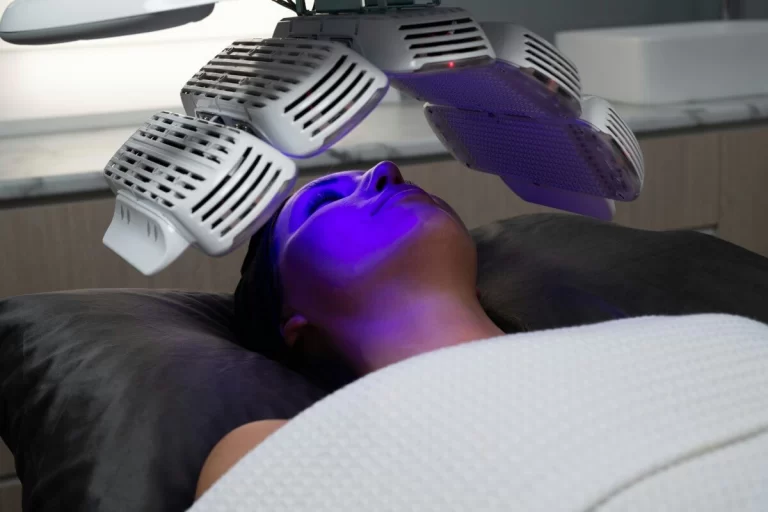At Youth Lab, our focus has always been on advanced aesthetic medicine and helping our clients achieve healthy, radiant skin. While many of the treatments we offer focus on improving skin tone, texture, and signs of ageing, there are times when a more medical approach is needed, especially when it comes to managing sun damage and precancerous lesions.
One treatment that has been gaining awareness in recent years is Photodynamic Therapy (PDT). While we don’t offer PDT at Youth Lab, we often work alongside our trusted colleagues at our sister clinic, Shade Skin Cancer Medicine, a dedicated skin cancer and skin check clinic, to ensure our clients receive the most appropriate care for their needs.
So what exactly is PDT, and when should you consider it?
Photodynamic Therapy is a non-surgical, light-based treatment used to target and destroy abnormal or damaged skin cells. It’s primarily used to treat actinic keratoses (AKs), precancerous sunspots, as well as some superficial non-melanoma skin cancers, including certain forms of basal cell carcinoma.
The process involves applying a light-sensitive solution (photosensitiser) to the affected skin. After a set incubation period, the area is then exposed to a specific wavelength of medical-grade light. This activates the solution and causes a reaction that selectively destroys sun damaged cells while leaving healthy tissue intact.
The result? Clearer skin, with reduced risk of those damaged cells progressing into something more serious.
Conditions Treated with PDT
PDT is most commonly used for:
- Solar or actinic keratoses – rough, scaly patches caused by long-term sun exposure, which can become cancerous if left untreated
- Superficial basal cell carcinoma – a slow-growing form of skin cancer in its early stages
- Extensive sun damage – particularly when affecting large surface areas like the face, scalp, chest or arms
It’s an excellent treatment option for those with multiple lesions, or for anyone seeking a non-invasive alternative to surgical removal.
Why We Don’t Offer PDT at Youth Lab
As much as we love providing cutting-edge treatments for skin health and rejuvenation, Photodynamic Therapy sits firmly within the realm of medical skin cancer management. Because it treats lesions that are potentially cancerous, it’s important that patients are assessed and treated under the guidance of a skin cancer doctor or qualified GP with additional training.
Our clinical team is here to support your skin health journey but when it comes to diagnosing and treating early skin cancers or precancerous changes, we’ll always refer you to the right experts. That’s where Shade Skin comes in.
Why We Recommend Shade Skin for PDT
Shade Skin is Youth Lab’s sister clinic, and it was created specifically to address the gap in early detection and treatment of skin cancer in Perth. With a team of experienced doctors who specialise in skin cancer medicine, Shade Skin offers comprehensive skin checks, biopsies, and treatment options including PDT.
What makes Shade Skin different is their patient-first approach with short waitlists, personalised care, and access to advanced non-surgical treatments like PDT in a modern, welcoming setting.
If you’re unsure whether your skin concerns are cosmetic or medical in nature, our team at Youth Lab is always happy to guide you. And if PDT is the right course of treatment, we’ll refer you directly to Shade Skin for a thorough assessment.
What to Expect After PDT: Downtime and Healing
Like most medical skin treatments, PDT does come with some downtime. The level of discomfort and healing time will vary depending on the area treated and the extent of sun damage.
Common post-treatment effects include:
- Redness and swelling (similar to sunburn) for a few days
- Crusting or peeling as damaged skin cells are shed
- Sun sensitivity in the treated area for up to 48 hours (strict sun avoidance is essential)
Most patients find the initial inflammation settles within 5–7 days, with noticeable skin improvement over the following weeks.
How Youth Lab Can Support Your Skin Post-PDT
Just because we don’t perform PDT at Youth Lab doesn’t mean your care ends once treatment is over. We regularly support clients following PDT with targeted skin recovery and maintenance treatments that promote healing, improve skin integrity, and help prevent further sun damage.
Some of the ways we can assist include:
- LED Light Therapy to accelerate healing and reduce inflammation
- Medical-grade skincare designed to repair the skin barrier and boost antioxidant protection
- Regular skin treatments like gentle peels and hydrating facials to maintain long-term skin health
- Tailored skin plans to help reduce the risk of new sun damage and support overall skin rejuvenation
We also provide personalised advice on sun protection strategies, lifestyle changes, and ongoing skin surveillance, particularly for clients with a history of sun exposure or skin cancer.
In Summary
Photodynamic Therapy is an effective, non-invasive option for treating precancerous sun damage and early skin cancers. While it’s not a treatment we offer at Youth Lab, we’re proud to collaborate with our colleagues at Shade Skin, where clients can receive expert care tailored to their medical needs.
If you’ve been told you may benefit from PDT, or if you’re concerned about any changes in your skin, please don’t hesitate to speak with our team. We’ll ensure you’re pointed in the right direction for treatment, and we’ll be here to support you throughout your recovery and beyond.
Your skin deserves the best care, both medical and aesthetic. And at Youth Lab, we’re here to make sure you get exactly that.



